Sungrow Power Supply Bundle
How Does Sungrow Power Supply Thrive in the Renewable Energy Sector?
Sungrow Power Supply Co., Ltd. stands as a global powerhouse, leading the charge in renewable energy with its cutting-edge Sungrow Power Supply SWOT Analysis. As the world's top PV inverter supplier and a highly bankable energy storage company, Sungrow's impact is undeniable. But how does this solar energy company actually work, and what fuels its impressive growth?
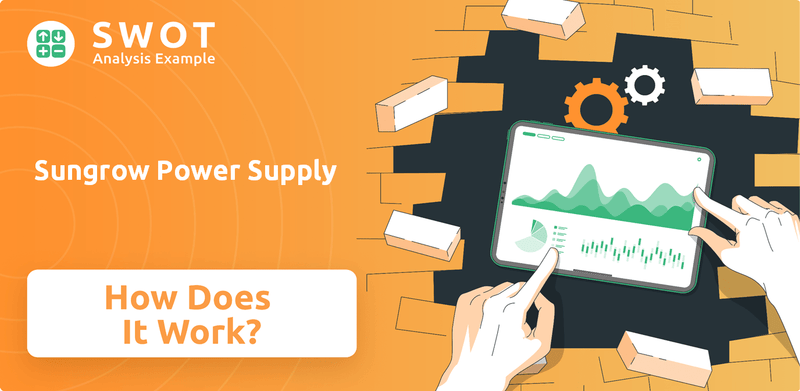
With a focus on innovation and strategic market expansion, Sungrow is revolutionizing the industry. This deep dive into Sungrow's operations will explore its core functions, revenue streams, and future prospects, providing a comprehensive understanding of its business model. From understanding how Sungrow inverters function to the company's history and its commitment to sustainability, this analysis offers valuable insights for anyone interested in the future of renewable energy and inverter technology.
What Are the Key Operations Driving Sungrow Power Supply’s Success?
The core of Sungrow's operations revolves around providing Sungrow power supply equipment for the renewable energy sector. This includes a diverse range of products, such as Sungrow solar inverters, wind power converters, energy storage systems (ESS), and solutions for electric vehicle (EV) charging. These products are designed to serve multiple customer segments, from large-scale utility projects to residential and commercial applications. The company's focus on innovation and technological advancement is key to its value proposition.
Sungrow's operational processes are comprehensive, encompassing manufacturing, sourcing, and extensive research and development. The company invests heavily in R&D, allocating approximately 6.5% of its revenue to this area in recent years. This commitment has resulted in over 9,401 cumulative patent applications and the co-development of more than 90 technical standards. Its global annual production capacity for inverters is a substantial 330 GW, with 25 GW outside of China and another 25 GW under construction.
A significant part of Sungrow's value proposition lies in its technological leadership and comprehensive product portfolio. This includes early adoption of advanced technologies, such as SiC devices in PV inverters, and the launch of a remote service platform in March 2024 to enhance customer support. The company's focus on advanced control algorithms and increased computing power boosts the efficiency and power density of its equipment. Sungrow's emphasis on innovation, combined with its strong relationships with major solar power companies, allows it to offer solutions that reduce costs, improve grid integration, and enhance system reliability for its customers.
Sungrow's main offerings include solar inverters, wind power converters, energy storage systems (ESS), and EV charging solutions. These products are designed for various applications, from residential to utility-scale projects. The company's diverse product range caters to the growing demands of the renewable energy market.
Sungrow serves a broad spectrum of customers, including utility-scale solar projects, distributed solar installations, and residential, commercial, and industrial (C&I) applications. This wide customer base allows Sungrow to capture diverse market opportunities. The company adapts its products to meet the specific needs of each segment.
Sungrow invests heavily in research and development, allocating approximately 6.5% of its revenue to this area. This commitment has led to numerous patents and the co-development of technical standards. The focus on innovation drives the development of more efficient and reliable inverter technology.
Sungrow has a significant global presence with a large annual production capacity for inverters, reaching 330 GW. A substantial portion of this capacity is located outside of China, with 25 GW already operational and another 25 GW under construction. This global footprint supports its ability to serve customers worldwide.
Sungrow's technological prowess is evident in its advanced control algorithms, increased computing power, and innovative thermal packaging. These advancements significantly improve the performance and reliability of its equipment. The company's early adoption of technologies like SiC devices in PV inverters demonstrates its commitment to innovation.
- Reduced Balance of System (BOS) costs.
- Enhanced grid integration capabilities.
- Improved system reliability.
- Launch of a remote service platform for better customer support.
Sungrow Power Supply SWOT Analysis
- Complete SWOT Breakdown
- Fully Customizable
- Editable in Excel & Word
- Professional Formatting
- Investor-Ready Format
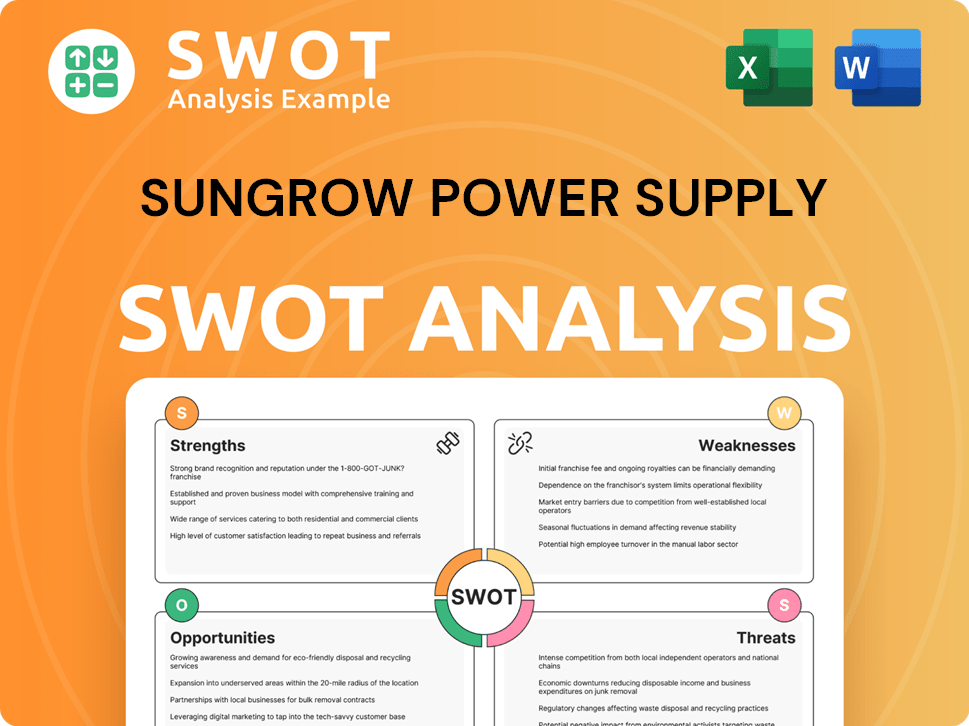
How Does Sungrow Power Supply Make Money?
Understanding the revenue streams and monetization strategies of a company like Sungrow is crucial for investors and industry analysts. The company's financial success is driven by a diversified approach, focusing on multiple key areas within the renewable energy sector. This strategy allows Sungrow to capitalize on various market opportunities and maintain a strong position in a rapidly evolving industry.
Sungrow's financial performance is underpinned by its core business segments and strategic market expansions. By analyzing these elements, stakeholders can gain valuable insights into the company's growth trajectory and long-term sustainability. The company's ability to adapt and innovate within the renewable energy market is a key factor in its financial success.
Sungrow's revenue streams are primarily divided into three main segments: PV inverters, energy storage systems (ESS), and new energy investment and development. In 2024, solar inverters accounted for 37% of the total revenue, with energy storage systems contributing 32%, and the new energy investment and development business representing 27%. The company's total revenue for the fiscal year 2024 reached 77.857 billion yuan.
The photovoltaic inverter business showed stable growth in 2024, with shipments of 147 GW. The energy storage system segment's revenue is projected to become the largest revenue contributor in 2025, reaching 37% of total revenue. In the first half of 2024, the energy storage systems business generated 7.816 billion RMB (approximately USD 1.1 billion), accounting for 25.20% of total revenue, with a gross profit margin of 40.8%. The new energy investment and development business involves Sungrow developing new energy projects for owners, earning a spread.
- Product Sales and Services: Sungrow's monetization strategies include product sales and services, with products contributing approximately 80% and services around 20% to total revenue.
- Geographical Market Expansion: The company focuses on expanding its presence in diverse geographical markets. In 2024, 47% of its revenue was generated from overseas markets, with about 16% from the US.
- Strategic Partnerships: Sungrow is expanding its market share in the EV sector through strategic partnerships. A 2023 collaboration with a major electric vehicle manufacturer to supply renewable energy solutions for charging stations is expected to generate revenues exceeding ¥1.5 billion (about $230 million USD) in the coming years.
For further insights into the company's market focus, consider exploring the Target Market of Sungrow Power Supply.
Sungrow Power Supply PESTLE Analysis
- Covers All 6 PESTLE Categories
- No Research Needed – Save Hours of Work
- Built by Experts, Trusted by Consultants
- Instant Download, Ready to Use
- 100% Editable, Fully Customizable
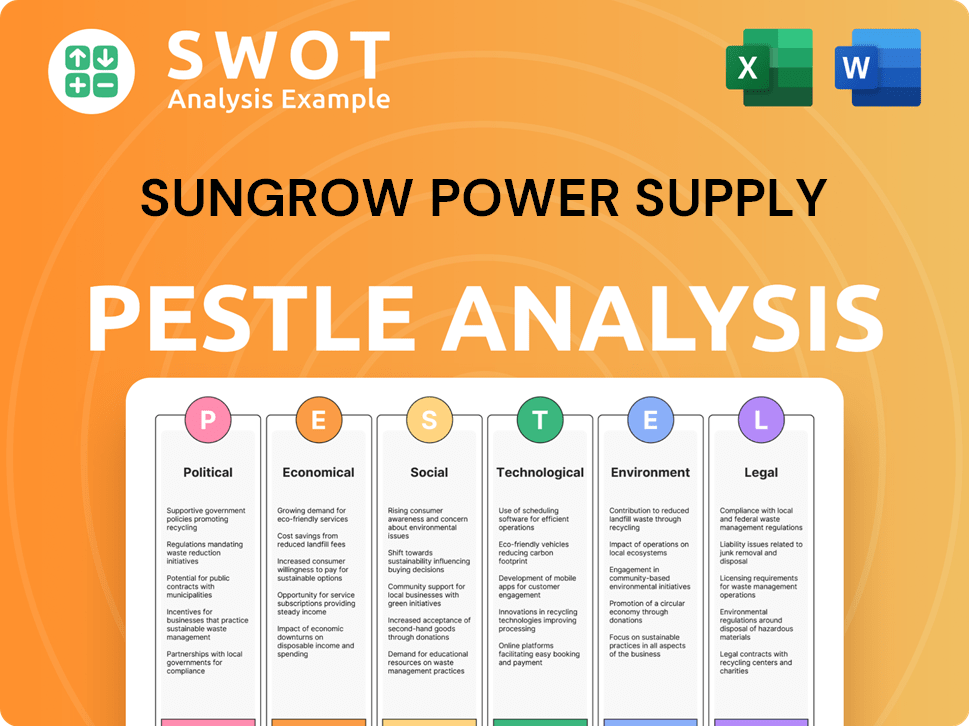
Which Strategic Decisions Have Shaped Sungrow Power Supply’s Business Model?
The journey of Sungrow has been marked by significant achievements and strategic initiatives. In 2024, the company demonstrated its global reach by installing power electronic converters with a capacity of 740 GW worldwide. This achievement solidified its position as a leading player in the renewable energy sector.
Sungrow's strategic moves have been pivotal in navigating the evolving market dynamics. The company has proactively responded to challenges, such as the anticipated moderation in global solar installations growth, by projecting an 8% compound annual growth rate in solar inverter revenue over the next five years. Furthermore, Sungrow has addressed geopolitical risks and trade protectionism through strategic manufacturing and supply chain adjustments.
In Q1 2024, the company secured bids for 5 GW of inverters, showcasing its strong market presence. Financial performance also reached new heights, with net profits surpassing 10 billion yuan for the first time in 2024. These milestones reflect Sungrow's robust growth and strategic adaptability in the competitive renewable energy landscape.
Sungrow's milestones include being recognized as the world's No. 1 in PV inverter shipments and the most bankable energy storage company in 2024. The company also achieved significant financial growth, with net profits exceeding 10 billion yuan for the first time.
Strategic moves include adapting to market changes by anticipating an 8% compound annual growth rate in solar inverter revenue and mitigating trade risks by shipping solar inverters from Thailand to the US. Plans for an overseas ESS factory are underway to start operations by the end of 2025.
Sungrow's competitive advantages stem from its brand strength, technological leadership, and economies of scale. Its comprehensive product portfolio and commitment to R&D, including advanced grid-forming capabilities and AI-powered battery pre-diagnosis systems, give it a significant edge in the market.
In 2024, Sungrow upgraded its brand strategy with the value proposition 'Bridge to a sustainable future', reflecting its core business and technological advancements. The company's focus on innovation and market adaptability positions it well for continued success. For further insights, explore the Growth Strategy of Sungrow Power Supply.
Sungrow's competitive edge is rooted in several key areas, including a comprehensive product portfolio that covers both utility-scale and distributed solar projects. This extensive range allows the company to cater to diverse market needs, setting it apart from smaller competitors. The company's strong emphasis on research and development, with a significant portion of its workforce dedicated to innovation, ensures it remains at the forefront of technological advancements.
- Technological Leadership: Continuous development of cutting-edge technologies, such as advanced grid-forming capabilities and AI-powered battery pre-diagnosis systems like iSolarBPS.
- Economies of Scale: Benefits from a well-established distribution network, facilitating quick scalability in emerging markets.
- Brand Strength and Market Position: Strong track record and established relationships with large solar power companies.
- Product Portfolio: Comprehensive product offerings for both utility-scale and distributed solar projects.
Sungrow Power Supply Business Model Canvas
- Complete 9-Block Business Model Canvas
- Effortlessly Communicate Your Business Strategy
- Investor-Ready BMC Format
- 100% Editable and Customizable
- Clear and Structured Layout
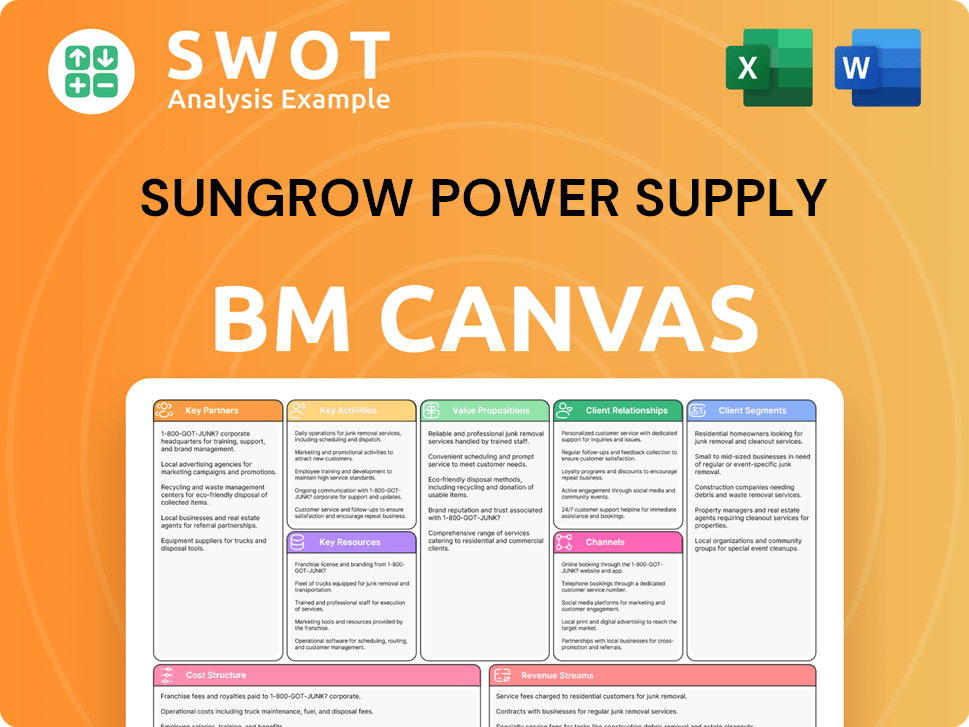
How Is Sungrow Power Supply Positioning Itself for Continued Success?
The company holds a strong position in the global renewable energy market. As a Sungrow solar inverters provider, it had over 20% market share by shipments in the solar inverter market in 2023. With innovations powering projects in over 180 countries as of December 2024, the company had installed 740 GW of power electronic converters globally.
Key risks include slowing demand, geopolitical factors, and volatile lithium-ion cell prices. Competition in the energy storage system market is intensifying, which is expected to lead to gross margin decline in this segment. The company has ambitious plans for the future, including revenue growth and expansion into new markets.
In 2024, the company was the No.1 Inverter Manufacturer and No.1 Residential Battery Manufacturer in Australia. In India, it emerged as the leading Sungrow solar inverters supplier with a 29.1% market share in 2024. The company also leads in installed distributed generation (DG) capacity in Brazil in 2024.
Slowing demand for solar and energy storage could decelerate inverter shipment growth. Geopolitical risks and high tariffs on energy storage systems shipped to the US from China pose challenges. Volatile lithium-ion cell prices and intensifying competition in the energy storage market also present risks.
The company forecasts revenue to grow at a 10% CAGR for 2024-29. Strategic initiatives include focusing on distributed solar and expanding in the module-level power electronics (MLPE) market. The company plans to invest in battery integration and enhance customer experience.
The company aims to achieve carbon neutrality at the operational level by 2028. It plans to extend this to its entire supply chain by 2038, targeting net-zero emissions across the supply chain by 2048. The company is committed to delivering high-performance, safe, and sustainable Sungrow energy solutions.
The company is focusing on distributed solar projects for improved cash flows. It is expanding its offerings in the module-level power electronics (MLPE) market with new microinverters and hybrid solutions in 2025. There is also a significant investment in battery integration for residential, commercial, and industrial projects.
- Focus on distributed solar to improve cash flows.
- Expansion in MLPE market with new microinverters and hybrid solutions.
- Investment in battery integration for various projects.
- Enhancement of processes and tools for improved customer experience.
Sungrow Power Supply Porter's Five Forces Analysis
- Covers All 5 Competitive Forces in Detail
- Structured for Consultants, Students, and Founders
- 100% Editable in Microsoft Word & Excel
- Instant Digital Download – Use Immediately
- Compatible with Mac & PC – Fully Unlocked
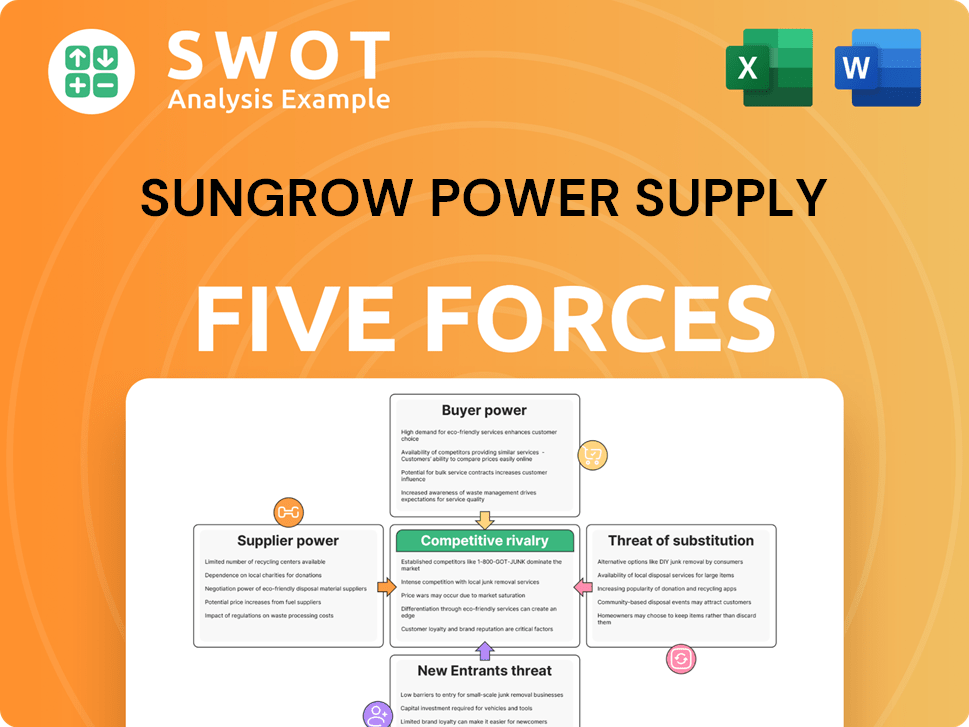
Related Blogs
- What are Mission Vision & Core Values of Sungrow Power Supply Company?
- What is Competitive Landscape of Sungrow Power Supply Company?
- What is Growth Strategy and Future Prospects of Sungrow Power Supply Company?
- What is Sales and Marketing Strategy of Sungrow Power Supply Company?
- What is Brief History of Sungrow Power Supply Company?
- Who Owns Sungrow Power Supply Company?
- What is Customer Demographics and Target Market of Sungrow Power Supply Company?
Disclaimer
All information, articles, and product details provided on this website are for general informational and educational purposes only. We do not claim any ownership over, nor do we intend to infringe upon, any trademarks, copyrights, logos, brand names, or other intellectual property mentioned or depicted on this site. Such intellectual property remains the property of its respective owners, and any references here are made solely for identification or informational purposes, without implying any affiliation, endorsement, or partnership.
We make no representations or warranties, express or implied, regarding the accuracy, completeness, or suitability of any content or products presented. Nothing on this website should be construed as legal, tax, investment, financial, medical, or other professional advice. In addition, no part of this site—including articles or product references—constitutes a solicitation, recommendation, endorsement, advertisement, or offer to buy or sell any securities, franchises, or other financial instruments, particularly in jurisdictions where such activity would be unlawful.
All content is of a general nature and may not address the specific circumstances of any individual or entity. It is not a substitute for professional advice or services. Any actions you take based on the information provided here are strictly at your own risk. You accept full responsibility for any decisions or outcomes arising from your use of this website and agree to release us from any liability in connection with your use of, or reliance upon, the content or products found herein.